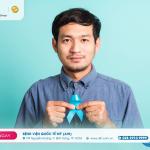Notification
Please fill in the information below
Urgent
PHIMOSIS: A COMMON BUT OFTEN OVERLOOKED MALE HEALTH ISSUE
Phimosis is a condition in which the foreskin (prepuce) cannot be retracted to fully expose the glans penis. This may be a normal developmental stage in children or a pathological result of inflammation, scarring, or other injuries. Phimosis can affect hygiene, urination, and sexual activity, and may lead to complications if not properly managed.
Classification
Phimosis is generally classified along two main axes:
1. Based on etiology:
Physiological phimosis: In newborns, the foreskin is often adherent or non-retractable. This natural adhesion usually resolves gradually over time without intervention.
Pathologic phimosis: Occurs because of recurrent infections, scarring, fibrosis, or dermatological conditions affecting the foreskin tissue.

2. Based on severity/clinical presentation
Mild phimosis: The foreskin is difficult to retract fully, even during erection, but causes no pain or complications.
Moderate phimosis: Presents with symptoms (difficulty urinating, inflammation); ballooning of the foreskin during urination may occur.
Severe phimosis: The foreskin cannot be retracted at all, even during erection, with chronic inflammation, affecting daily activities and sexual function.
Causes
Pathological causes of phimosis include:
Recurrent inflammation of the glans or foreskin (balanitis, balanoposthitis), which causes swelling that limit skin elasticity.
Trauma or injury to the foreskin (e.g., from improper hygiene or forceful retraction) that may lead to fibrosis.
Dermatological conditions, changes of skin tissue structure (e.g., fibrosis, hyperkeratosis, or other coexisting disorders) that could reduce elasticity.
Congenital causes: At birth, the foreskin may be adherent or incompletely separated by a thin membrane. This is one of the conditions commonly managed in pediatric surgery when symptoms are present.
Symptoms
Clinical presentation of phimosis varies depending on severity:
Most children with physiologic phimosis have no significant symptoms unless hygiene or urination is affected.
Difficulty urinating / narrow urinary stream, weak urinary stream, or ballooning of the foreskin during urination due to urine accumulation under the prepuce.
Dermatitis, balanitis, or balanoposthitis, balanoposthitis-balanitis characterized by redness, pain, discharge, or foul odor.
Pain during erection or sexual intercourse (in adults).
Possible burning sensation, increased frequency, or interrupted urination.
In severe cases, complications such as paraphimosis (when the retracted foreskin cannot be pulled forward to its normal position) or urinary tract infection may occur.

Diagnosis
The diagnostic process includes:
1. Clinical examination
History taking: Ask about the onset of symptoms, recurrent infections, pain, and any impact on urination or sexual activity.
Physical examination of the foreskin: Assess the retractability of the foreskin when flaccid and erect, presence of swelling, scarring, elasticity, edema, or inflammation.
2. Differentiation between physiologic and pathologic types:
In young children, physiologic adhesions of the foreskin are usually observed because this may resolve naturally with age.
If there are recurrent infections, scarring, functional impairment (difficulty urinating, pain, or abnormal foreskin structure), the condition is considered pathologic.
3. Supporting tests (if needed):
If inflammation is suspected, perform urinalysis or urine culture.
In cases of dermatological trauma or injury suspected due to underlying dermatologic disease, a biopsy or dermatology consultation may be indicated.
Evaluate urinary functions if symptoms such as urgency or recurrent difficulty in urination are present.

Treatment
Depending on the severity and impact, phimosis management can be either conservative or surgical.
1. Conservative treatment:
Good hygiene: Keep the area under the foreskin clean and avoid forceful or aggressive retraction.
Topical corticosteroids: help reduce inflammation and improve foreskin elasticity; this is often combined with gentle stretching exercises over time. (Johns Hopkins recommends circumcision when conservative management fails.)
Treatment of infection or inflammation if present (antibiotics, hygiene).
2. Surgical intervention:
Circumcision: This procedure is indicated in cases of severe phimosis, recurrent inflammation, or functional impairment.
Postoperative care: Ensure proper wound healing, avoid tension, maintain hygiene, and refrain from sexual activity during the recovery period. In adults, postoperative symptoms may include swelling, redness, or discomfort during urination, with sexual function typically restored after about 4–6 weeks.

Phimosis is a common condition, particularly in young children, with most physiological cases resolving spontaneously. When symptoms such as inflammation occur, affecting urination and sexual intercourse, or pathological scarring occur, intervention is required. Conservative management, especially the use of topical corticosteroids combined with gentle stretching, should be attempted before surgery is considered. Surgical intervention (circumcision) remains the standard treatment in various cases, especially severe ones.
Reference:
Raffles Medical Group
--------------------
Search
Latest News
Our Doctor





































































Leave a comment